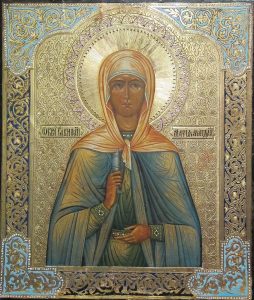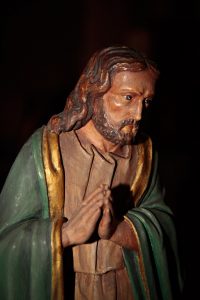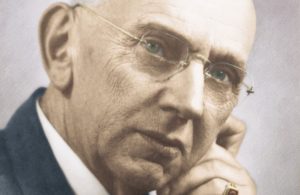“After this, Jesus traveled about from one town and village to another, proclaiming the good news of the kingdom of God. The Twelve were with him, and also some women who had been cured of evil spirits and diseases: Mary (called Magdalene) from whom seven demons had come out; Joanna the wife of Chuza, the manager of Herod’s household; Susanna; and many others. These women were helping to support them out of their own means.” Luke 8:1-3, NIV
Mary Magdalene is familiar to many inside and outside of the Christian faith as one of the companions of Jesus of Nazareth; we have met her several times previously (“First Apostle,” “Translating Scripture 2”).  The two other women mentioned in Luke 8, Joanna and Susanna, are much less familiar. While we can know almost nothing about them, what scholars can discern helps us to further understand the ministry of Jesus and the larger context of what later became Christianity. It is also interesting to consider what paranormal research might reveal about the lesser-known women in Jesus’ circle.
The two other women mentioned in Luke 8, Joanna and Susanna, are much less familiar. While we can know almost nothing about them, what scholars can discern helps us to further understand the ministry of Jesus and the larger context of what later became Christianity. It is also interesting to consider what paranormal research might reveal about the lesser-known women in Jesus’ circle.
Joanna
Joanna is mentioned here and in Luke 24:10 but nowhere else in the New (Christian) Testament. In both places in Luke, Joanna is mentioned along with Mary Magdalene, although the other named woman in chapter 24 is “Mary mother of James,” not Susanna.
That Joanna is identified by her position as the wife of Herod (Antipas) is significant at several levels. The word used to describe husband Chuza’s position – epitropos – means steward, household manager, or trusted “official that looked after the king’s financial interests.” This position could have been held by a slave or former slave (Pervo, 103); Kraemer (“Women’s Judaism(s),” 56) implies that Chuza and Joanna were indeed slaves.
That Joanna, Susanna and the other women were supporting Jesus’ ministry “out of their own means” suggests that they had at least some control of their own finances. At the same time, how could a slave or former slave have funds and control over them?
Furthermore, what do we make of the wife of a high-placed official presumably leaving her husband and not only following an itinerant preacher on his travels but also helping pay his expenses? Would that not have embarrassed such an official and given him reason for divorce? Is it significant that Joanna does not seem to be divorced or widowed? If Chuza were still in the picture, was he “a very tolerant husband” (Pervo, 103)?
 Since Herod was not against Jesus at the beginning according to Luke (23:8), it seems possible that Joanna’s devotion to Jesus was not a problem for Herod’s household. Later, we see examples from the readings of Edgar Cayce showing that some of the women around Jesus lived in important religious and political households of the time.
Since Herod was not against Jesus at the beginning according to Luke (23:8), it seems possible that Joanna’s devotion to Jesus was not a problem for Herod’s household. Later, we see examples from the readings of Edgar Cayce showing that some of the women around Jesus lived in important religious and political households of the time.
Also, the early Jesus movement did benefit from the assistance of a certain number of independent women. As Pervo notes, “Wives of this sort populate the non-canonical Acts of the Apostles, where their rebellion and embracing of celibacy make considerable contributions to the plots of these second- and third-century works” (“Joanna,” 103). If Joanna were such a wife, it is noteworthy that she appears in a NT text (written and circulated 80-130 CE) – this is fairly early in the tradition.
This “helping” aspect of the women around Jesus is an indication of the emerging distinction between women’s and men’s leadership roles in the movement. According to D’Angelo (“Reconstructing,” 117; and “[Re]constructions,” 185), the women in Luke 8 and elsewhere are described as having been healed in some way or another by Jesus and minister to him, while it is only men who can become official apostles: Lk 6:12-13 and Acts 1:21.  The general exclusion of women from leadership roles in Christianity, of course, became the norm. This gender distinction in roles, of course, runs counter to what we have seen in Paul’s earlier letter to the Romans: Paul names at least one woman explicitly as an apostle – Junia.
The general exclusion of women from leadership roles in Christianity, of course, became the norm. This gender distinction in roles, of course, runs counter to what we have seen in Paul’s earlier letter to the Romans: Paul names at least one woman explicitly as an apostle – Junia.
Luke does demonstrate with this brief mention of Joanna that there were (married) Jewish women – perhaps slaves – in the Jesus movement who had relatively high social status, independence, and control of their own funds. Even if they could not function in the same ways the apostles did, their financial support was critical to the movement – and continued in subsequent generations.
Susanna
Luke 8 is the only place that Susanna is mentioned in the NT. Since so many women in the early Jesus movement were invisible and unnamed, the fact that she is named may or may not have meaning. She may have been “less notable than Mary Magdalene and Joanna, but sufficiently prominent to be singled out” (Pervo, “Susanna 2,” 158).
 Like Joanna, Susanna is described by Luke as a woman who followed Jesus and assisted him financially out of her own resources; she is also said to have been healed in some way by Jesus. As Karen King reminds us, these relationships mean that Jesus indeed “spoke to women both in public and private, and indeed he learned from them.” This basic observation – that Jesus had close relationships with women – often gets lost in the Christian tradition, which focuses primarily on the men of the movement, their close relationships with Jesus, and the words purportedly spoken by them.
Like Joanna, Susanna is described by Luke as a woman who followed Jesus and assisted him financially out of her own resources; she is also said to have been healed in some way by Jesus. As Karen King reminds us, these relationships mean that Jesus indeed “spoke to women both in public and private, and indeed he learned from them.” This basic observation – that Jesus had close relationships with women – often gets lost in the Christian tradition, which focuses primarily on the men of the movement, their close relationships with Jesus, and the words purportedly spoken by them.
We might be able to assume that Susanna was single – either quite young and never married or widowed; Luke does not say. Like Joanna, she too may have been a slave or freedperson. Perhaps she was Joanna’s sister or the sister of one of the male followers of Jesus. At any rate, she was able to travel with Jesus and his other followers and provide him/them with a level of financial support, presumably without needing a relationship with or permission from a man (husband, father, brother, uncle, owner, etc.).
The Holy Women of Edgar Cayce’s Readings
Edgar Cayce (1877-1945) came to be known as the “sleeping prophet.”  Born on a farm in Hopkinsville, Kentucky, Cacye grew up as a devoted church goer and Sunday school teacher but realized early on that he had special psychic abilities. Over the course of 40 years, he gave “readings” to thousands of seekers while in an unconscious state. His legacy continues with the work of the Association of Research and Enlightenment.
Born on a farm in Hopkinsville, Kentucky, Cacye grew up as a devoted church goer and Sunday school teacher but realized early on that he had special psychic abilities. Over the course of 40 years, he gave “readings” to thousands of seekers while in an unconscious state. His legacy continues with the work of the Association of Research and Enlightenment.
Many of Cayce’s readings revealed information about the life of Jesus, his ministry and the people around him. Anne Read has compiled data from a wide selection of these readings and discovered revelations about more than 60 named people in Jesus’ circle (Read, 185-86). Read noticed in her research that people Cayce was reading were being told that they were among a group of “Holy Women” around Jesus, about which there is no specific mention in the Bible. The readings did not seem to indicate any kind of organized group but rather individuals who had dedicated their lives to Jesus and the movement (Read, 103).
The Holy Women, mostly Jewish, were teachers of the message that Jesus was delivering and provided him with companionship and support.  Some were married, a number were apparently present with Jesus and the disciples during various miracles recounted in the NT texts, and some served as hired mourners at the deaths of Lazarus, Jesus and others (Read, passim). As we know from other sources as well as from Cayce, women helped with food preparation, the weaving of cloth, and the preparation of Jesus’ (and others’) bodies for burial. Women as well as men were converted to the Jesus movement when they witnessed the various miracles (Read, passim). And a woman named Agatha, a Galilean, was “an instructress, a teacher in the garrisons of the Roman people, [who] interpret[ed] for the wives” (Read, 131).
Some were married, a number were apparently present with Jesus and the disciples during various miracles recounted in the NT texts, and some served as hired mourners at the deaths of Lazarus, Jesus and others (Read, passim). As we know from other sources as well as from Cayce, women helped with food preparation, the weaving of cloth, and the preparation of Jesus’ (and others’) bodies for burial. Women as well as men were converted to the Jesus movement when they witnessed the various miracles (Read, passim). And a woman named Agatha, a Galilean, was “an instructress, a teacher in the garrisons of the Roman people, [who] interpret[ed] for the wives” (Read, 131).
Names of the Holy Women included Maipah, Eloise, Josie, Susane (though no Susanna), Ulai, Martha the wife of the Jewish leader Nicodemus, Thelda, a Phoebe (not the same Phoebe as in Romans 16), a Sylvia from Tyre and Sidon, Sarapha, Mariaerh, and Eunice. There are many parallels between what came through in Cayce’s readings about Jesus’ followers and what is reported in the NT or that has been discerned through scholarship. The readings add an interesting and helpful dimension to our knowledge of Jesus’ times and the women around him.
Conclusion
As NT scholars have demonstrated for over a century, the Gospels were written from certain theological perspectives (not to mention in first-century contexts much different than our own) that make it imperative for modern readers to realize that their narratives are not necessarily “historical” or “factual” in our modern sense.
- Did Herod really have a steward named Chuza, and was that man’s wife named Joanna?
- Did that Joanna really follow Jesus and others in his travels and help the movement financially?
- Was Susanna a real person and a follower and possible patron of Jesus, or did Luke invent her for certain reasons?
If these were examples of real women around Jesus, how could they have had control of their own funds?
- Did they inherit these funds or earn them through some kind of work or occupation?
- Had they truly been cured of evil spirits and/or disease by Jesus, or was that a device of the Gospel writer?
- Are these stories reflections of Jesus’ times and milieu or of the Gospel writers many generations later?
How do the Cayce readings overlap with what is written in the Gospels and/or with what scholarship has shown us about the early Jesus movement? How do they differ? Do the Cayce readings help us learn about the movement that became Christianity, or should they be ignored?
In short, all kinds of evidence – literary, archaeological and paranormal – are valuable in their own way when it comes to women and their roles. Women were truly “players” in the early Jesus movement – not only followers of Jesus and financial supporters but also leaders – alongside their male counterparts. The women of Luke 8 provide another window into the movement and women’s roles in it.
Resources
D’Angelo, Mary Rose. “Reconstructing ‘Real’ Women from Gospel Literature: The Case of Mary Magdalene,” Ross Shepard Kraemer and Mary Rose D’Angelo, eds. Women and Christian Origins, 105-28. New York and Oxford: Oxford University Press, 1999.
D’Angelo, Mary Rose. “(Re)presentations of Women in the Gospels of Matthew and Luke-Acts,” in Ross Shepard Kraemer and Mary Rose D’Angelo, eds. Women and Christian Origins, 171-95. New York and Oxford: Oxford University Press, 1999.
King, Karen L. “Women In Ancient Christianity: The New Discoveries,” PBS Frontline, April 1998.
Kraemer, Ross S. “Jewish Women and Christian Origins,” in Ross Shepard Kraemer and Mary Rose D’Angelo, eds., Women and Christian Origins, 35-49. New York and Oxford: Oxford University Press, 1999.
Kraemer, Ross S. “Jewish Women and Women’s Judaism(s) at the Beginning of Christianity,” in Ross Shepard Kraemer and Mary Rose D’Angelo, eds., Women and Christian Origins, 50-79. New York and Oxford: Oxford University Press, 1999.
Pervo, Richard I. “Joanna,” in Carol Meyers, Toni Craven and Ross S. Kraemer, eds., Women in Scripture: A Dictionary of Named and Unnamed Women in the Hebrew Bible, the Apocryphal/Deuterocanonical Books, and the New Testament, 102-03. Grand Rapids, MI, and Cambridge, England: William B. Eerdmans Publishing Company, 2000.
Pervo, Richard I. “Susanna 2,” in Carol Meyers, Toni Craven and Ross S. Kraemer, eds., Women in Scripture: A Dictionary of Named and Unnamed Women in the Hebrew Bible, the Apocryphal/Deuterocanonical Books, and the New Testament, 158-59. Grand Rapids, MI, and Cambridge, England: William B. Eerdmans Publishing Company, 2000.
Read, Anne. Edgar Cayce on Jesus and His Church. New York: Warner Books, Inc., 1970.
